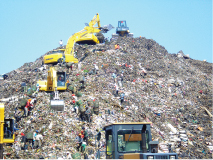11.1.2 Waste production
At the other end of the input–output model, outputs from organisations in the form of waste are also significant. It is not possible to determine global waste outputs from organisations specifically, but about 1.3 billion tonnes of municipal solid waste is produced each year – and expected to grow to 2.2 billion tonnes per year by 2025 (Hoornweg and Bhada-Tata, 2012). About 40 million tonnes of electronic waste is created each year (Schluep et al., 2009) and this is also expected to grow significantly, even with recycling initiatives.
In the UK as with many countries, waste is a significant issue. It is estimated that:
- of the 600 million tonnes of products and materials entering the UK economy each year, only 115 million tonnes is recycled (Wrap, 2012)
- 50% of local authority collected waste was sent to landfill in 2010–11, compared with an EU average of 40% (DEFRA, 2012)
- in 2009, the UK produced approximately 8.3 million tonnes of food and drink waste, 7.0 million tonnes of which was uneaten food (DEFRA, 2012)
- 52% of commercial and industrial waste was recycled or reused in England in 2009, compared with 42% in 2002–03 (DEFRA, 2012)
- between 2012 and 2020, electronic waste in the UK will total more than 12 million tonnes, of which 3 million tonnes will be IT equipment, consumer electronics and display screens – this 12 million tonnes will include precious metals with a total estimated market value of £7 billion (at 2012 prices) (Wrap, 2012)
- nearly 25% of waste electrical and electronic equipment taken to household waste recycling centres could be re-used, worth around £200 million gross a year (Wrap, 2012).
These figures are fairly high level and may be hard to picture in terms of scale or attributing waste generation directly to individual organisations or sectors. But they give a reasonable sense of the waste situation in the UK and the economic, as well as environmental, impacts.
In both the water and waste examples, the message is clear – organisations need to be active in managing their relationships with their environment not just in terms of impacts arising from their activities, but also because of their dependency on natural resources as inputs to their activities and products.

